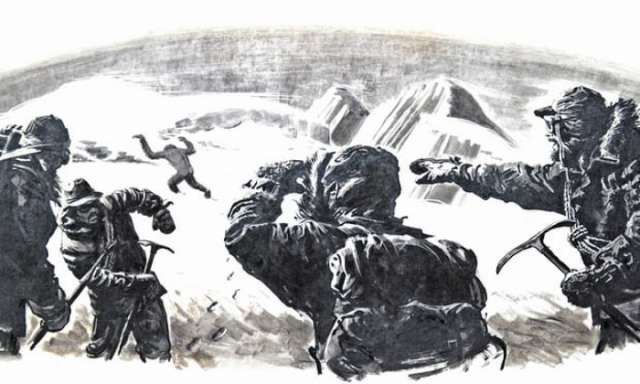Just one sample, taken from a curious stuffed “yeti”, bucked the trend – the creature turned out to be a taxidermy mash-up boasting the hair of a bear and the teeth of a dog.
“It demonstrates that modern science can really try and tackle some of these mysteries and unsolved questions that we have,” said Dr Charlotte Lindqvist, an expert on bear genomics and co-author of the research from the University at Buffalo.
The study is not the first time it has been suggest the yeti might be more ursine than abominable.
A recent study, based on genetic analysis from samples purportedly from yeti-like creatures the world over, found that while most of the samples came from known animals, two from Bhutan and the Indian Himalayas were more mysterious. The team suggested they might be from an unknown species of bear, or a descendant from a hybrid of a polar and brown bear.
A footprint purporting to be that of the abominable snowman, taken near Mount Everest in 1951. Photograph: Topical Press Agency/Getty Images
But Lindqvist was unconvinced, pointing out there was too little data to rule out a more mundane explanation. “I just didn’t trust these claims,” she said.
Lindqvist and colleagues examined nine samples gathered by a company shooting a film on the topic. Sources included mummified animals found in monasteries, hair collected by nomadic herdsmen, bone from a spiritual healer and a stuffed “yeti” from the Messner Mountain Museum.
The team also analysed 15 other samples from zoos, national parks and museums, the majority of which were known to be from Himalayan brown bears.
The analysis, which was based on sequences of DNA from the energy powerhouses of the cell known as mitochondria, involved a comparison of all of the samples with genetic data from a large international database.
“Of those nine samples, eight of them matched local bears that are found in the region today,” said Lindqvist, adding that the ninth sample was the dog tooth from the stuffed yeti. “The purported yetis from the Tibetan plateau matched Tibetan brown bears, the ones from the western Himalayan mountains matched the Himalayan brown bear and then, at possibly slightly lower altitude were Asian black bears.”
Lindqvist added that the finding produced mixed emotions. “That was obviously very interesting to me, perhaps slightly disappointing to the film company,” she said, adding that the new samples also helped the team to gain new insights into the evolutionary “family tree” of bears.
But Lindqvist says she doubts the study will be the final word on the yeti. “I am sure, though, that the legend and the myth will live on,” she said. “You can never for sure prove that there is nothing out there.”
The results, published in Proceedings of the Royal Society B, are likely to disappoint cryptozoologists. Jonathan Downes, director of the Centre for Fortean Zoology, said that while he applauded the scientific work and agreed that many samples are obviously from bears, he believes the mystery is not yet solved.
“I think there is still a possibility that there are unknown species of higher primate which are still awaiting discovery in what used to be Soviet central Asia,” he said.
More about: #DNA















































